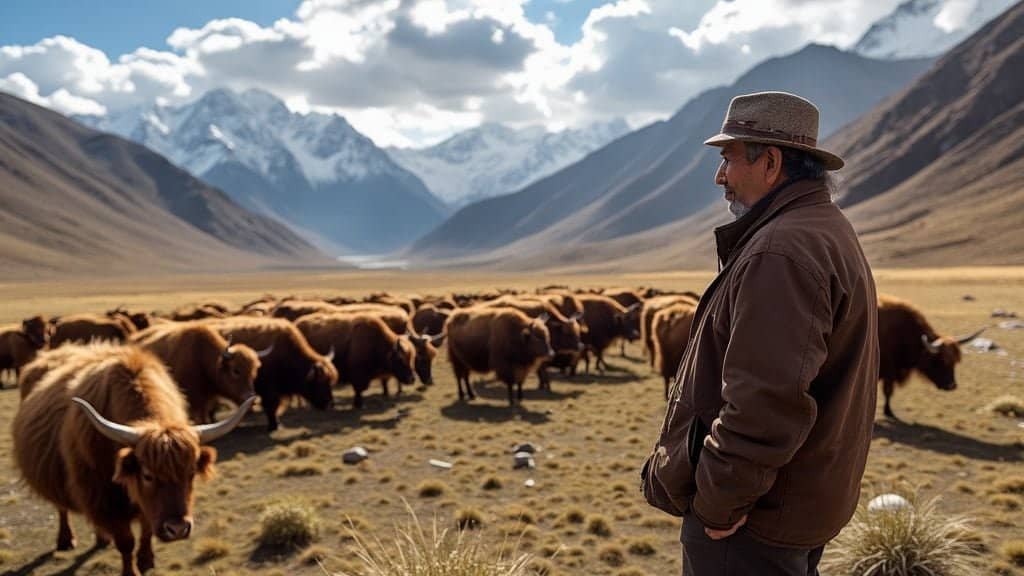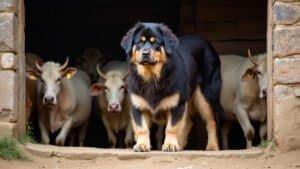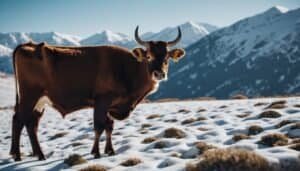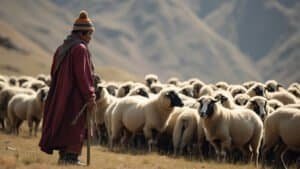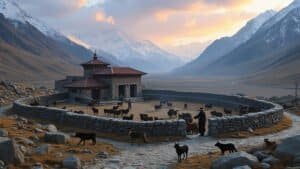Introduction
Snow leopard attacks on livestock are a significant concern for rural communities living near snow leopard habitats. These attacks lead to substantial financial losses, impacting the livelihoods of local farmers and herders
This article explores the economic impact of these attacks, including the immediate financial losses, the long-term effects on rural economies, and the support systems available to affected communities
Additionally, we’ll examine preventive measures, the role of conservation efforts, and the delicate balance between protecting this endangered species and safeguarding the livelihoods of those living in its proximity
Economic Impact of Snow Leopard Attacks on Livestock
Snow leopard attacks on livestock have far-reaching economic impacts on rural communities that rely heavily on animal husbandry
These predators, primarily found in the mountainous regions of Central and South Asia, often prey on domestic animals such as sheep, goats, and yaks, leading to significant financial losses for farmers
This section delves into the various dimensions of the economic impact caused by these attacks, including direct financial losses, their effect on rural livelihoods, and the long-term economic consequences for communities living in snow leopard habitats
Financial Losses from Livestock Depredation
The direct financial losses resulting from snow leopard attacks are often devastating for rural farmers
Livestock represents a primary source of income, food, and cultural significance in these regions. The value of livestock varies depending on the species, but in many areas, a single animal can be worth several hundred dollars, a significant sum for families living in poverty
A study by the International Snow Leopard Trust (2021) found that in some regions, farmers lose up to 12% of their livestock annually to snow leopard predation. For example, in Mongolia, the loss of a single goat or sheep can equal a month’s income for a herder
This financial blow is particularly harsh in regions where alternative income sources are scarce. In the Indian state of Himachal Pradesh, losses have been estimated at around $100,000 annually across affected communities, a substantial economic drain for these rural economies
The frequency of attacks can vary depending on several factors, including the time of year, availability of wild prey, and proximity to snow leopard habitats. During the harsh winter months, when natural prey becomes scarce, snow leopards are more likely to venture closer to human settlements, increasing the risk of livestock predation
This seasonal pattern exacerbates the financial strain on farmers, who may lose several animals in a short period, leaving them with fewer resources to sustain their families through the winter
Impact on Rural Livelihoods
The economic impact of snow leopard attacks extends beyond the immediate loss of livestock. In many rural areas, the loss of animals directly affects the livelihood of entire families and communities
Livestock provides not only income but also essential resources such as milk, wool, and meat. When these animals are killed, families lose access to these vital resources, forcing them to either buy them from other sources or go without, which can lead to malnutrition and other health issues
Moreover, the loss of livestock can lead to increased poverty and vulnerability. Families that lose a significant portion of their livestock may find themselves unable to afford school fees for their children, medical expenses, or other basic needs
This economic pressure can also push families to take on debt, further entrenching them in poverty. In some cases, farmers might sell off their remaining livestock at lower prices to cover immediate expenses, leading to long-term economic instability
The social impact is equally profound. In many of these regions, livestock farming is deeply intertwined with cultural practices and traditions. The loss of livestock can disrupt traditional ways of life, leading to a loss of cultural heritage
For example, in parts of Nepal, the loss of yaks, which are central to both the economy and culture, can have a ripple effect throughout the community, affecting not just individual families but the entire social fabric
Long-Term Economic Consequences
The long-term economic consequences of snow leopard attacks on livestock are complex and multifaceted. Over time, repeated losses can lead to a decrease in the overall number of livestock in a community, reducing the local economy’s productivity
As livestock numbers dwindle, so do the associated economic activities, such as trading in livestock products, local markets, and related industries like wool processing and leather goods production
Moreover, the fear of snow leopard attacks can discourage farmers from expanding their herds or investing in other agricultural activities. This risk aversion limits economic growth and perpetuates poverty cycles in these regions
Additionally, the psychological toll of living under the constant threat of livestock attacks can lead to stress and anxiety, further reducing farmers’ ability to make long-term economic decisions that would benefit their households and communities
In some cases, communities might resort to retaliatory killings of snow leopards to protect their livestock, which, while understandable, can lead to legal consequences and further economic hardship. These actions also undermine conservation efforts, which aim to balance the protection of snow leopards with the economic well-being of local communities
For example, the Snow Leopard Trust has implemented community-based conservation programs that offer financial incentives to farmers who agree not to kill snow leopards in retaliation for livestock losses. However, these programs require ongoing support and funding to be sustainable
The cumulative effect of these factors—direct financial losses, impact on livelihoods, and long-term economic consequences—paints a bleak picture for communities affected by snow leopard attacks. Without effective interventions, these economic challenges are likely to persist, further marginalizing already vulnerable populations
Preventive Measures Against Snow Leopard Attacks
Preventive measures play a crucial role in reducing the frequency and severity of snow leopard attacks on livestock. By implementing effective strategies, farmers and herders can protect their animals while coexisting with this endangered predator
This section explores various preventive techniques, including physical barriers like fencing, livestock guarding practices, and the innovative use of technology to minimize the risk of attacks
Fencing and Protective Structures
One of the most straightforward and widely adopted preventive measures against snow leopard attacks is the use of fencing and protective structures. These physical barriers are designed to keep snow leopards away from livestock, especially during vulnerable times such as night or during birthing seasons
In many high-altitude regions, traditional corrals are reinforced with stone walls or metal mesh to make them more resistant to predator incursions. For example, in Ladakh, India, local communities have been building predator-proof corrals using wire mesh and strong wooden beams
These structures, often funded by NGOs like the Snow Leopard Conservancy, have proven effective in reducing livestock losses. A study conducted by the Snow Leopard Conservancy (2020) found that predator-proof corrals reduced livestock losses by up to 50% in areas where they were implemented
Another innovative approach is the construction of solar-powered electric fences. These fences deliver a non-lethal shock to deter snow leopards from approaching livestock pens. While the initial cost of installing electric fences can be high, they offer a long-term solution that requires minimal maintenance and has been shown to be effective in multiple regions, including Mongolia and Kyrgyzstan
However, the effectiveness of these structures depends on their proper construction and maintenance. Poorly built or inadequately maintained fences can fail to keep out snow leopards, leading to continued livestock losses. Therefore, community training and ongoing support are essential components of any fencing initiative
Livestock Guarding Practices
In addition to physical barriers, traditional livestock guarding practices remain an essential part of preventing snow leopard attacks. These practices have been used for centuries and often involve the use of guard animals, herding techniques, and human vigilance
Guard dogs, particularly breeds native to mountainous regions, are highly effective in deterring snow leopards. Breeds like the Tibetan Mastiff have been used for generations to protect herds. These dogs are trained to stay with the livestock and aggressively defend them from predators
Research conducted by the Global Snow Leopard & Ecosystem Protection Program (GSLEP) in 2019 showed that herders using guard dogs experienced a significant reduction in livestock losses compared to those who did not use them
Another effective guarding practice is the close herding of livestock, particularly during high-risk periods. By keeping animals in tighter groups and under constant watch, herders can more easily detect and respond to the presence of snow leopards. In regions like the Altai Mountains, herders use traditional herding techniques, often passed down through generations, to minimize the risk of attacks
However, these practices are labor-intensive and may not be feasible for all farmers, particularly those with large herds or limited family labor. Additionally, the effectiveness of guarding practices can be influenced by the terrain and weather conditions, making them less reliable in some areas
Role of Technology in Prevention
The integration of modern technology into traditional livestock protection strategies has opened new avenues for preventing snow leopard attacks. GPS tracking, motion-sensor cameras, and automated deterrent systems are among the tools increasingly being used to protect livestock
GPS tracking devices attached to livestock allow herders to monitor the location and movement of their animals in real-time. This technology helps herders keep their livestock within safer zones and quickly respond if the animals stray into areas where snow leopards are known to hunt
In Kyrgyzstan, pilot programs using GPS collars have shown promise in reducing the number of livestock lost to predators by enabling more effective herd management
Motion-sensor cameras, often used for wildlife monitoring, are also being repurposed to help prevent snow leopard attacks. These cameras can be set up around livestock pens to detect the presence of predators
When a snow leopard is detected, the system can trigger alarms, lights, or even send alerts to the herders’ mobile phones, allowing for a timely response. This technology is particularly useful in remote areas where human presence is limited, and attacks are more likely to go unnoticed
Automated deterrent systems, such as lights or sounds triggered by motion sensors, can also help keep snow leopards at bay. For instance, flashing lights or loud noises can scare off predators, reducing the likelihood of an attack. These systems are relatively low-cost and can be set up to operate autonomously, making them an attractive option for small-scale farmers
Despite the promise of technology in preventing snow leopard attacks, challenges remain. Access to these technologies can be limited by cost, lack of infrastructure, and technical know-how. Furthermore, the effectiveness of technological solutions often depends on their integration with traditional practices and community involvement
Programs that combine modern technology with local knowledge and training have shown the most success in reducing livestock losses and fostering coexistence between humans and snow leopards
Support Systems for Affected Communities
Communities affected by snow leopard attacks on livestock often face significant economic and social challenges. To help mitigate these impacts, various support systems have been developed, ranging from government assistance programs to community-based initiatives
This section explores the different forms of support available, including government and NGO assistance, livestock insurance, and community-based conservation efforts
Government and NGO Assistance Programs
Government and non-governmental organizations (NGOs) play a crucial role in providing support to communities affected by snow leopard attacks. These programs often focus on financial compensation, training, and resources to help farmers and herders protect their livestock and recover from losses
In many regions, governments have established compensation schemes to reimburse farmers for livestock lost to snow leopard predation. These programs are designed to reduce the financial burden on farmers and discourage retaliatory killings of snow leopards
For instance, the Indian government has implemented compensation schemes in states like Himachal Pradesh and Uttarakhand, where snow leopard attacks are common. These programs typically cover a portion of the market value of the lost livestock, helping to alleviate some of the economic pressure on affected families
However, the effectiveness of government compensation programs can vary. Delays in payments, insufficient coverage, and bureaucratic hurdles often limit their impact. A study conducted by the Wildlife Institute of India in 2022 highlighted that while compensation programs are essential, many farmers remain dissatisfied due to the time it takes to receive payments and the perceived inadequacy of the amounts provided
NGOs have stepped in to fill some of these gaps, offering additional financial support and resources. Organizations like the Snow Leopard Trust and Panthera run community-based programs that provide direct financial aid, build predator-proof corrals, and offer training in livestock management
These NGOs often work closely with local communities to ensure that the support provided is culturally appropriate and addresses the specific needs of the region
In some cases, NGOs also facilitate access to alternative livelihoods, such as eco-tourism or handicrafts, which can help reduce dependence on livestock and provide additional income streams. For example, the Snow Leopard Enterprises program, initiated by the Snow Leopard Trust, helps communities in Mongolia and Kyrgyzstan produce and sell handcrafted goods
The income generated from these products helps offset the losses from snow leopard attacks, providing a more sustainable economic foundation for these communities
Livestock Insurance and Compensation
Livestock insurance is another critical tool for mitigating the economic impact of snow leopard attacks. Insurance schemes allow farmers to recover some or all of the value of their lost livestock, providing a financial safety net that can prevent them from falling into poverty
In regions where snow leopard attacks are common, specialized livestock insurance programs have been developed to address this specific risk. These programs, often subsidized by governments or NGOs, offer coverage at affordable rates to encourage participation
For instance, in Pakistan’s Gilgit-Baltistan region, the World Wide Fund for Nature (WWF) has implemented a livestock insurance scheme that compensates farmers for animals lost to predators. The program has been successful in reducing financial losses and improving attitudes toward snow leopard conservation
However, the success of livestock insurance programs depends on several factors, including the level of coverage, ease of access, and the claims process. Farmers must trust that their claims will be honored promptly and that the compensation will be sufficient to cover their losses
In some cases, low participation rates and limited awareness have hindered the effectiveness of these programs. Therefore, ongoing education and outreach efforts are essential to ensure that more farmers take advantage of available insurance options
In addition to formal insurance schemes, some communities have developed informal compensation systems based on traditional practices. These systems often involve pooling resources within a community to compensate members who lose livestock to predators. While these systems may not provide as much financial security as formal insurance, they can be more accessible and culturally aligned with local practices
Community-Based Conservation Initiatives
Community-based conservation initiatives have emerged as a vital component in supporting communities affected by snow leopard attacks. These initiatives aim to balance the needs of local populations with the conservation of snow leopards, fostering coexistence rather than conflict
One of the most successful models is the establishment of community-managed conservation areas, where local residents take an active role in protecting snow leopards and their habitats. In return, they receive financial benefits from conservation-related activities, such as eco-tourism or sustainable resource management
In Nepal, for example, the Annapurna Conservation Area Project has involved local communities in conservation efforts, leading to a reduction in snow leopard attacks and an increase in community income from tourism
Another important aspect of community-based conservation is education and awareness. Programs that educate local populations about the ecological importance of snow leopards and the benefits of conservation can help change negative perceptions and reduce retaliatory killings
These programs often include workshops, school education programs, and community meetings, where residents can learn about non-lethal ways to protect their livestock and the long-term benefits of preserving snow leopard populations
In some regions, community-based initiatives also include schemes that directly link conservation success with economic incentives
For example, in Mongolia, a program called “Conservation Contracts” rewards communities with cash payments or development projects if no snow leopards are killed in their area over a set period. This approach not only helps protect snow leopards but also provides tangible economic benefits to the communities involved
Overall, support systems for communities affected by snow leopard attacks are diverse and multifaceted. By combining government compensation programs, livestock insurance, and community-based conservation initiatives, these efforts help reduce the economic burden on farmers and promote the coexistence of humans and snow leopards
However, the success of these systems depends on their accessibility, effectiveness, and the level of community engagement, highlighting the need for continued investment and innovation in these areas
Snow Leopard Conservation and Its Economic Implications
Snow leopard conservation is a complex issue that requires balancing the preservation of an endangered species with the economic well-being of the communities living within their habitats
This section explores how conservation efforts can impact local economies, both positively and negatively, and discusses the importance of sustainable practices in ensuring the long-term survival of snow leopards and the communities that share their environment
Balancing Conservation and Livelihoods
The challenge of balancing snow leopard conservation with the livelihoods of local communities is a central concern in regions where these predators are found
On one hand, snow leopards are a keystone species, playing a crucial role in maintaining the health of the ecosystems they inhabit. On the other hand, their predation on livestock can lead to significant economic losses for rural communities, as previously discussed
Effective conservation strategies must consider the economic needs of these communities while also protecting snow leopards. One approach that has gained traction is the development of community-based conservation programs that involve local populations in the conservation process
These programs often provide financial incentives for communities to engage in conservation activities, such as monitoring snow leopard populations or protecting their natural prey
For example, the Snow Leopard Trust’s Community-Based Conservation Program in Mongolia engages herders in snow leopard monitoring and habitat protection efforts. In return, the herders receive support for improving livestock management practices, such as better fencing or access to veterinary care, which helps reduce losses to snow leopard predation
This program has not only contributed to the conservation of snow leopards but also improved the livelihoods of participating herders by reducing the economic impact of livestock losses
However, the success of these programs depends on their ability to offer tangible economic benefits that outweigh the costs of living alongside snow leopards. Ensuring that conservation efforts do not disproportionately burden local communities is crucial for the long-term success of these initiatives
Economic Benefits of Snow Leopard Tourism
Snow leopard tourism has emerged as a significant economic opportunity for communities living near snow leopard habitats
Wildlife tourism, particularly eco-tourism, can provide a sustainable source of income that supports both conservation and local development. When managed responsibly, snow leopard tourism can create jobs, generate revenue, and promote awareness of the importance of conserving this iconic species
In regions like Ladakh, India, and the Chitral Valley in Pakistan, snow leopard tourism has become a growing industry. Tourists from around the world are drawn to these remote areas for the chance to see snow leopards in their natural habitat, contributing to the local economy through spending on accommodation, food, guide services, and souvenirs
A study by the Snow Leopard Trust (2022) found that snow leopard tourism in Ladakh contributes significantly to the local economy, providing income for hundreds of households
However, the development of snow leopard tourism must be carefully managed to ensure that it benefits local communities and does not harm the environment. Over-tourism, habitat degradation, and disruption of snow leopard behavior are potential risks if tourism is not controlled
To mitigate these risks, many regions have implemented community-based tourism models, where local residents have a stake in the tourism industry and are involved in decision-making processes
For instance, in Nepal, the Snow Leopard Conservation Program has developed community-managed tourism initiatives that include strict guidelines for tourist behavior, limits on the number of visitors, and reinvestment of tourism revenue into local conservation efforts
These initiatives help ensure that snow leopard tourism remains sustainable and beneficial for both conservation and local communities
Sustainable Livestock Management Practices
Sustainable livestock management practices are essential for reducing the conflict between snow leopards and human populations. By improving the resilience of livestock herding to predation, these practices can help mitigate the economic impact of snow leopard attacks while supporting conservation goals
One key approach is the adoption of predator-friendly herding techniques, such as rotational grazing, which can help reduce the likelihood of livestock encountering snow leopards
Rotational grazing involves moving livestock between different grazing areas to avoid overgrazing and reduce the time animals spend in high-risk areas. This practice not only protects livestock but also promotes healthier pastures, which can support more sustainable livestock production in the long term
In addition, improving the quality of livestock through selective breeding and better veterinary care can help herders maintain smaller, healthier herds that are less vulnerable to predation. For example, in Kyrgyzstan, conservation programs have introduced selective breeding techniques to improve the resilience of yaks and sheep to both harsh environmental conditions and predator attacks
By maintaining healthier herds, herders can reduce their dependence on large livestock numbers, thereby minimizing the economic impact of any losses due to snow leopard predation
Furthermore, integrating traditional knowledge with modern practices can enhance the effectiveness of sustainable livestock management. Many indigenous communities have developed sophisticated herding practices that minimize the risk of predator attacks
By combining these traditional practices with modern technology, such as GPS tracking and predator-proof enclosures, communities can create more effective and sustainable livestock management systems
Overall, sustainable livestock management practices are a critical component of snow leopard conservation. By reducing the economic impact of snow leopard predation, these practices help foster coexistence between humans and snow leopards, ensuring that both the species and the communities that share its habitat can thrive
Conclusion
The economic impacts of snow leopard attacks on livestock are profound and multifaceted, affecting the livelihoods of rural communities that depend heavily on animal husbandry
Financial losses from livestock depredation can be devastating, leading to poverty and food insecurity, while the long-term economic consequences can hinder the development and sustainability of these regions. However, preventive measures, including the use of protective structures, livestock guarding practices, and modern technology, offer effective solutions to mitigate these impacts
Support systems, such as government and NGO assistance programs, livestock insurance, and community-based conservation initiatives, play a crucial role in helping affected communities cope with the economic challenges posed by snow leopard attacks
These programs not only provide financial relief but also promote the coexistence of humans and snow leopards by encouraging sustainable practices and conservation efforts
Snow leopard conservation, while essential for preserving this endangered species, also brings economic implications. The balance between conservation and livelihoods, the potential for snow leopard tourism, and the adoption of sustainable livestock management practices are key factors in ensuring that both snow leopards and the communities sharing their habitat can thrive together
Through a combination of preventive measures, support systems, and sustainable practices, it is possible to mitigate the economic impacts of snow leopard attacks on livestock while also contributing to the conservation of this iconic species
The success of these efforts will depend on continued collaboration between governments, NGOs, and local communities, with a focus on creating solutions that are both economically viable and environmentally sustainable
